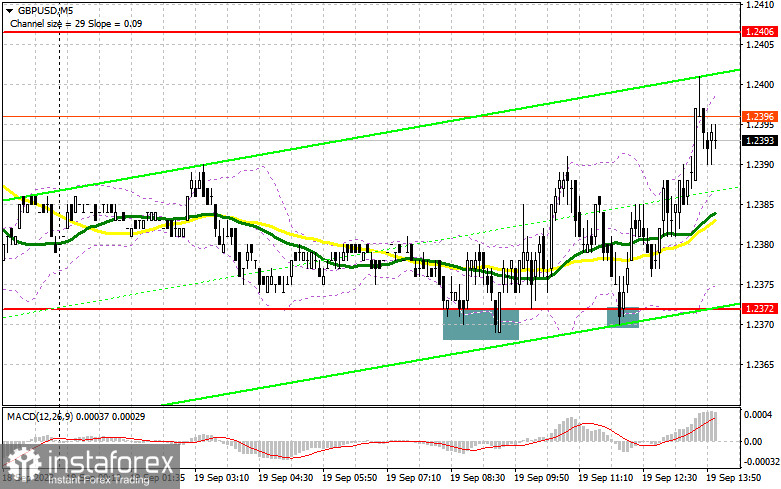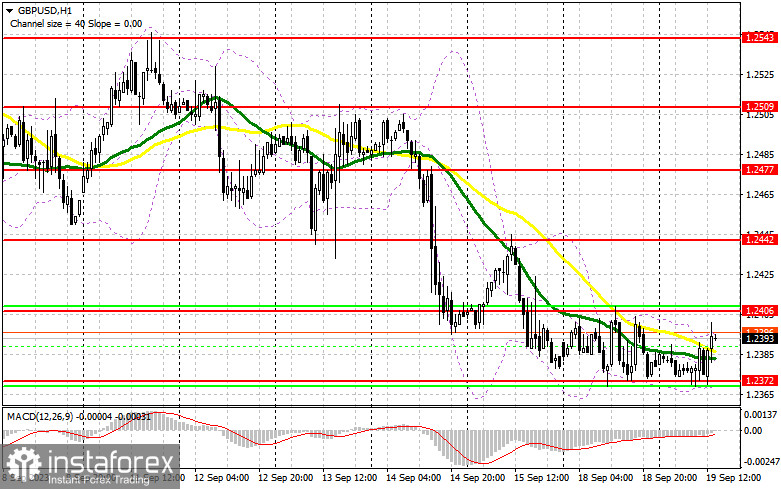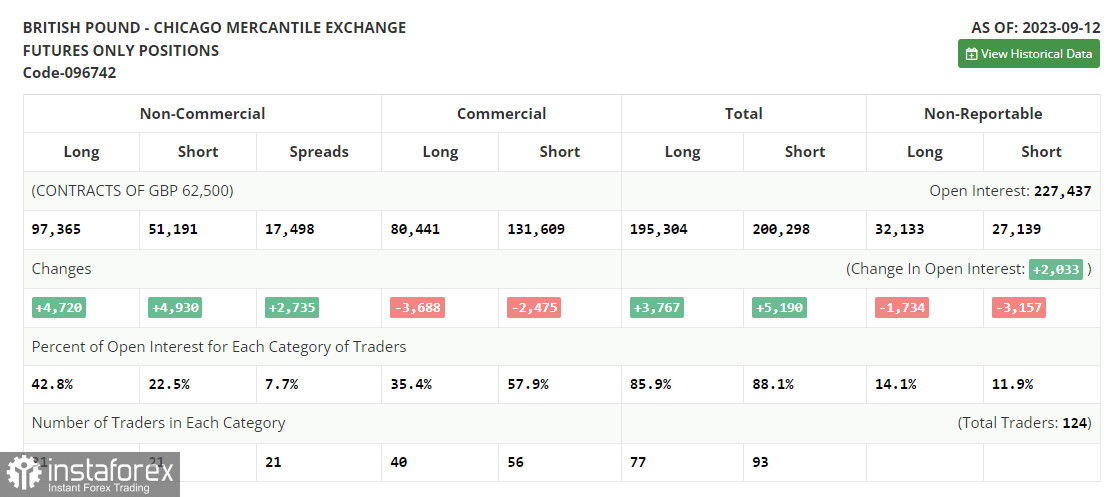In my morning forecast, I drew attention to the level of 1.2372 and recommended making trading decisions based on it. Let's look at the 5-minute chart and analyze what happened there. A decline and the formation of a false breakout at 1.2372 led to a buy signal, resulting in the pair rising by almost 30 points. In the second half of the day, the technical picture remained unchanged.

To open long positions on GBP/USD, the following is required:
Considering the low trading volume and the relatively weak bearish sentiment near the monthly minimum, it is possible to continue betting on the upward correction of the pair in the second half of the day. However, we are awaiting data on the volume of building permits and the number of new foundation placements in the USA. Positive indicators will pressure the pair; large buyers, still at 1.2372, must step in again. Forming a false breakout at this level will provide another entry point for long positions. In this case, the target will be resistance at 1.2406, just below the moving averages that favor sellers. Breaking through and consolidating above this range will strengthen buyer confidence, signaling the open long positions with an exit towards 1.2442, where I expect larger sellers to emerge. The ultimate target is the area around 1.2477, where I will take profit. In the scenario of a decline to 1.2372 and the absence of buyer activity in the second half of the day, which is likely to be the case, the pressure on the pound will only increase, opening the path to new monthly lows. In this case, only the defense of 1.2340, as well as a false breakout there, will provide a signal to open long positions. I plan to buy GBP/USD immediately on a bounce from the 1.2308 minimum with a 30-35 point intraday correction target.
To open short positions on GBP/USD, the following is required:
Only the defense of the nearest resistance at 1.2406 and a false breakout at that level in the second half will be a suitable entry point for short positions, opening the way back to the monthly minimum of 1.2372. Breaking through and testing this range from bottom to top will deal a more serious blow to the bullish positions, providing an opportunity for a decline toward the support at 1.2340. The more distant target remains the area around 1.2308, where I will take profit. In the event of an increase in GBP/USD during the American session and the absence of activity at 1.2406, where sellers should show themselves relatively quickly, buyers will have an excellent chance for a correction, especially if US real estate market data disappoints. In this case, I will postpone selling until a false breakout at 1.2442. Without a downward movement, I will sell the pound immediately on a bounce from 1.2477, but only with the expectation of a 30-35 point intraday correction.

In the COT report (Commitment of Traders) as of September 12, both long and short positions increased. Recent data on wage growth in the UK, which negatively affects inflation and the contraction of the UK GDP, have led to another sale of the British pound, which may intensify soon. In addition to the Bank of England meeting, where it is unclear how they will handle interest rates, a report on the Consumer Price Index is scheduled. Almost all economists expect increased inflationary pressure in the UK in August of this year. You understand what this can lead to against the backdrop of a weakening economy - another major sale of the pound against the US dollar. The latest COT report states that long non-commercial positions increased by 4,720 to 97,365, while short non-commercial positions also jumped by 4,930 to 51,191. As a result, the spread between long and short positions increased by 2,735. The weekly price dropped and reached 1.2486 compared to 1.2567.

Indicator signals:
Moving averages
Trading occurs around the 30 and 50-day moving averages, indicating a sideways market.
Note: The author considers the period and prices of moving averages on the H1 hourly chart, which differ from the general definition of classical daily moving averages on the D1 daily chart.
Bollinger Bands
In the event of a decrease, the lower boundary of the indicator at around 1.2372 will act as support.
Description of Indicators:
• Moving average (a moving average that determines the current trend by smoothing volatility and noise). Period - 50. Marked on the chart in yellow.
• Moving average (a moving average that determines the current trend by smoothing volatility and noise). Period - 30. Marked on the chart in green.
• MACD indicator (Moving Average Convergence/Divergence – convergence/divergence of moving averages). Fast EMA – period 12. Slow EMA – period 26. SMA – period 9.
• Bollinger Bands. Period - 20.
• Non-commercial traders – speculators, such as individual traders, hedge funds, and large institutions using the futures market for speculative purposes and meeting certain requirements.
• Long non-commercial positions represent the total long open positions of non-commercial traders.
• Short non-commercial positions represent the total short open positions of non-commercial traders.
• The total non-commercial net position is the difference between short and long positions of non-commercial traders.
 English
English 
 Русский
Русский Bahasa Indonesia
Bahasa Indonesia Bahasa Malay
Bahasa Malay ไทย
ไทย Español
Español Deutsch
Deutsch Български
Български Français
Français Tiếng Việt
Tiếng Việt 中文
中文 বাংলা
বাংলা हिन्दी
हिन्दी Čeština
Čeština Українська
Українська Română
Română

